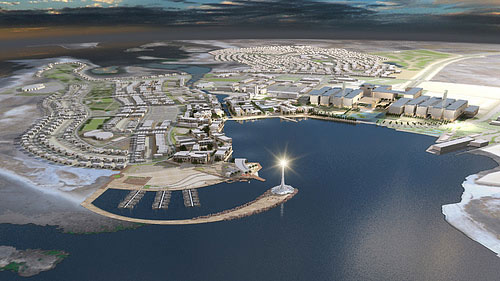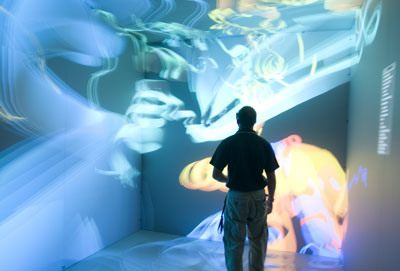| Posted: Sep 24, 2009 | |
Preparing for life after oil - top research in the desert |
|
| (Nanowerk Spotlight) Sand. Shrubs. Burst tires. More sand. The last thing you would expect as you drive along the Red Sea near Mecca is to encounter an ultramodern science city. Yet there it is. Appearing after an 80 kilometer drive from Jeddah, Saudi Arabia’s second-largest city, the 36 square kilometer campus of King Abdullah University for Science and Technology (KAUST) appears like a Fata Morgana out of the desert sand. | |
| Yesterday, September 23rd, King Abdullah of Saudi Arabia officially opened the country's most modern and ambitious university near the old fishing village of Thuwal. Nanowerk was invited to attend the spectacular opening ceremony. | |
| Much more than a future elite university, the vision behind KAUST is to create the nucleus of a modern society, free from the strict religious dictates of a conservative Islamic culture, and laying the foundation for a science and technology based society of future generations. | |
| This sounds quite ambitious for a conservative Islamic country that doesn't have public entertainment facilities such as cinemas or theaters – they are regarded as incompatible with Islam; where most schools have focused on religion much more than on science and other modern knowledge; and where a strict interpretation of Islam imposes many restrictions on women's daily lives. | |
| This all is supposed to change with mega projects like the $8bn Knowledge Economic City (KEC), the King Abdullah Economic City (KAEC) a $26.6 billion project that will generate more than 500,000 jobs upon completion in 2016; and nearby KAUST, intended to catapult Saudi Arabia’s education system into the 21st century and prepare its society for the time after oil. This move to a knowledge-based society is a top priority for the country – in 2009 alone, 25.7% of Saudi Arabia's budget has been allocated to educational development. | |
 |
|
| The KAUST campus and community site is located on the shores of the Red Sea, adjacent to the fishing village of Thuwal and 80 kilometers north of Jeddah, Saudi Arabia's second largest city. The total area comprises more than 36 million square meters, including the University campus, Harbor District commercial center, three distinct residential neighborhoods and a unique coral-reef ecosystem immediately off shore. | |
| Designed after Western elite universities (the former presidents of MIT and Cornell University are advisors), KAUST has been built as an international graduate-level research university, offering an M.S. degree and a Ph.D. program, and is governed by a fully independent, self-perpetuating Board of Trustees that comprises international leaders in academia, science, finance, industry, and public life. | |
| Right now, though, the KAUST campus is more like a science ghetto, a modern enclave in the desert that bears no resemblance to the region surrounding it. Here, women are part of the faculty – they even are allowed to drive cars on campus – but if they leave the campus these freedoms stay behind and the abaya, the black overgarment women are expected to wear, comes back on. | |
| Nevertheless, as Choon Fong Shih, the university’s first president explains, the ambitious goals of KAUST are to become, within the next 15-20 years, one of the leading research universities in the world. "Saudi Arabia sees KAUST as a catalyst to bring about a new age of scientific achievement" he says. "Western countries have invested in their universities for centuries. The investment in higher education and research is a recent development for this part of the world and I believe in time we will see the fruit and the benefit." | |
| The facts are impressive. It shows what vision paired with plenty of funding can create (KAUST is rumored to have a $10 billion endowment; that's in addition to the construction cost of at least $2-3 billion; the government and university are extremely tight-lipped about this and won't confirm any numbers). KAUST is trying to leverage a very diverse set of international research partnerships to support its development. The list of partner universities reads like a Who’s Who of the academic world: Caltech, Cornell, MIT, Stanford, Berkeley, Georgia Tech, TU Munich, CNRS, Imperial College London, University of Tokyo, National University of Singapore, University of Toronto, and many more. Among corporate research partnerships you’ll find names like IBM, Dow Chemical, Schlumberger, Sumitomo Chemical or Boeing. | |
| KAUST’s inaugural student body is equally diverse. From 7,200 applications the university has accepted over 800 students from 61 countries and 161 undergraduate institutions. 374 of those have begun their classes this month. | |
| To support and drive KAUST’s research agenda, the University has identified four primary strategic research thrusts and several interdisciplinary Research Centers that will apply science and technology to problems of human need, social advancement, and economic development: | |
|
|
|
| To support its research agenda, KAUST has established several Core Labs and major facilities, equipped with the best technology and instruments money can buy. We had a chance to tour the impressive facilities that will also enable top-notch nanotechnology research. | |
| The Nanofabrication, Imaging, and Characterization Core Lab consists of a clean-room environment equipped with leading-edge tools to support research in advanced materials, biotechnology, electronics and photonics, and MEMS/NEMS. | |
| The Imaging and Characterization Labs include a suite of 10 advanced nuclear magnetic resonance (NMR) spectrometers and facilities for scanning, transmission, confocal, and Raman microscopy, magnetic and thermal measurements, allowing scientists to examine nanostructure devices and surfaces down to the level of individual atoms. | |
| Biosciences and bioengineering contains facilities that include genomic and proteomic labs essential to the study of cellular molecules for DNA sequencing and genetic analysis, as well as the investigation of cellular processes. The genomics facility is equipped with robots and laboratory automation. | |
 |
|
| A KAUST researcher within the Cornea Visualization Center | |
| CORNEA is a fully immersive, six-sided virtual reality facility that gives students and researchers the ability to turn data into 3D structures that they can interact with and examine. It was built in partnership with the University of California, San Diego. | |
|
|
|
| Shaheen – the Arabic word for peregrine falcon – is the fastest supercomputer in the Middle East and one of the most powerful in the world. Developed with IBM, it is capable of 222 teraflops, or 222 trillion floating point operations per second. In non-technical language, this means Shaheen can solve 222 trillion complicated calculations per second. | |
| Laying the foundation for a country-wide research infrastructure, these cutting-edge laboratories at KAUST will be linked to other research institutions in the Kingdom and the region through the new 10 gigabytes per second Saudi Arabian Advanced Research and Education Network (SAREN). | |
| Between the 8th and 13th centuries, while Europe was in the Dark Ages, the Arab world was an intellectual center of science and learning with the famous House of Wisdom in Bagdad attracting the best minds of the known world. Arab scholars were active in, among other fields, medicine, astronomy, optics and mathematics (the word algorithm derives from Al Khwarizmi, a mathematician at the House of Wisdom in the 9th century). With its massive investment in education and amazing highlights like KAUST, the country is trying to rekindle the Arab spirit of learning and scientific inquiry and create a second House of Wisdom. How a country with a religious police (the Mutaween) known for its ruthlessness will reconcile the demands of a modern scientific environment that is based on freedom of inquiry and unrestricted flow of information with the strict and conservative environment of its Islamic theocracy remains to be seen. KAUST, however is a very impressive step in this direction. | |
 By
Michael
Berger
– Michael is author of three books by the Royal Society of Chemistry:
Nano-Society: Pushing the Boundaries of Technology,
Nanotechnology: The Future is Tiny, and
Nanoengineering: The Skills and Tools Making Technology Invisible
Copyright ©
Nanowerk LLC
By
Michael
Berger
– Michael is author of three books by the Royal Society of Chemistry:
Nano-Society: Pushing the Boundaries of Technology,
Nanotechnology: The Future is Tiny, and
Nanoengineering: The Skills and Tools Making Technology Invisible
Copyright ©
Nanowerk LLC
|
|
|
Become a Spotlight guest author! Join our large and growing group of guest contributors. Have you just published a scientific paper or have other exciting developments to share with the nanotechnology community? Here is how to publish on nanowerk.com. |
|
